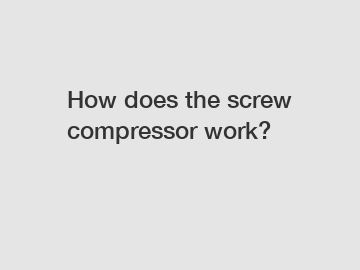How does the screw compressor work?
How Does the Screw Compressor Work?
A screw compressor is a type of positive displacement compressor that uses two intermeshing screws to compress air or gas. It is widely used in various industries, including oil and gas, manufacturing, construction, and more. In this article, we will explore the working principle of a screw compressor and understand its key components and functions.
Working Principle of Screw Compressor.

The screw compressor works on a simple yet effective principle. It consists of two helical rotors, known as screws, which rotate in opposite directions inside a cylindrical chamber. As the screws rotate, the gas or air is trapped between the screw lobes and the chamber walls. The volume of the trapped air decreases as it moves towards the discharge end of the chamber, resulting in increased pressure.
Key Components and Functions.
1. Rotors: The heart of the screw compressor is the intermeshing rotors. These precision-engineered screws have helical lobes that allow them to create pockets or voids where the air is trapped and compressed. The rotors are designed to maintain a small gap between each other to ensure efficient compression.
2. Cylindrical Chamber: The rotors are housed inside a cylindrical chamber, also known as the stator. It provides a controlled environment for the rotors to rotate and compress the air. The chamber is typically oil-injected to lubricate the rotors and reduce friction.
3. Air/Fluid Inlet: The screw compressor has an inlet where air or fluid enters the chamber. The inlet is equipped with a filter that removes any contaminants present in the incoming air or fluid. This ensures the smooth operation and longevity of the compressor.
4. Discharge Outlet: Once the air or fluid is compressed, it is discharged through an outlet at the end of the chamber. The outlet is connected to a pipe or hose that delivers the compressed air or fluid to its intended application.
5. Control System: A screw compressor is equipped with a control system that regulates its operation. It monitors various parameters such as pressure, temperature, and speed and adjusts them accordingly to ensure optimal performance. The control system also includes safety features that protect the compressor from overload and other potential risks.
Advantages of Screw Compressor.
- Screw compressors offer a higher efficiency compared to other compressor types. Their rotary motion provides continuous airflow, resulting in smooth, pulsation-free output.
- They have a compact design, making them suitable for tight spaces and mobile applications.
- Screw compressors are known for their low noise levels, thanks to their smooth operation and minimal vibration.
- They are highly reliable and require minimal maintenance, reducing downtime and overall operating costs.
Conclusion.
In conclusion, screw compressors are widely used in various industries for their efficient and reliable performance. By understanding their working principle and key components, we can appreciate their role in providing compressed air or gas for countless applications. Whether it is powering pneumatic tools, controlling industrial processes, or supplying clean air for breathing, screw compressors play a crucial role.
If you have any further questions about screw compressors or would like to explore our range of products, please do not hesitate to contact us. Our team of experts is here to assist you.
Are you interested in learning more about Low Pressure Screw Air Compressor, OIL-FREE SCREW BLOWERS, High Pressure Screw Air Compressor? Contact us today to secure an expert consultation!
210
0
0

Comments
All Comments (0)